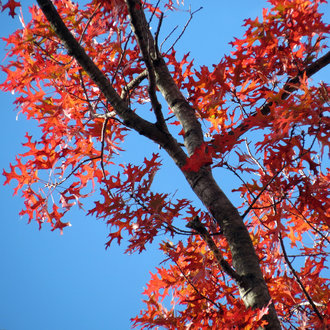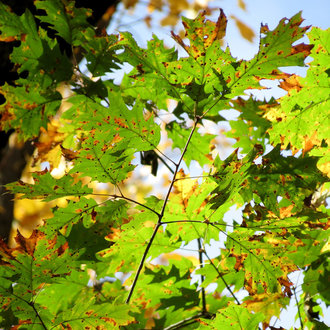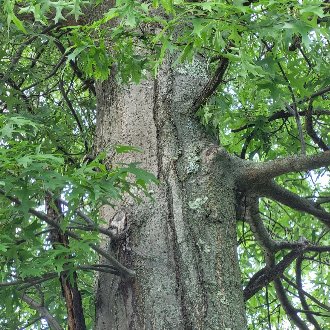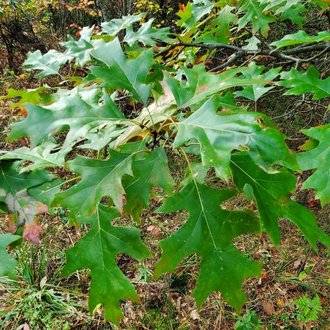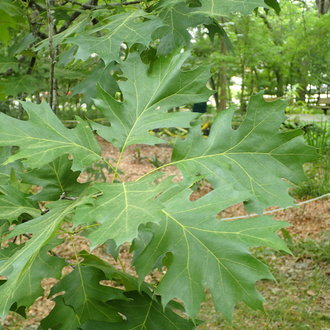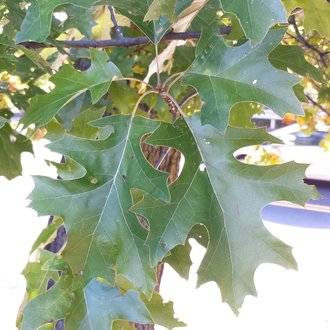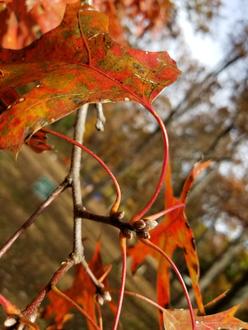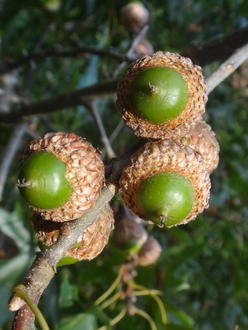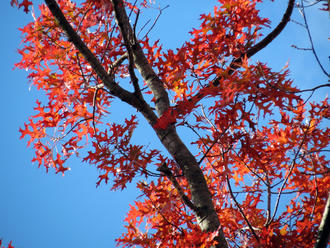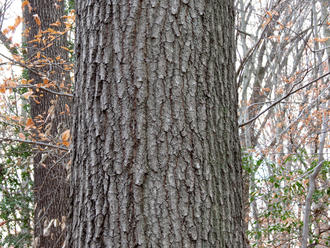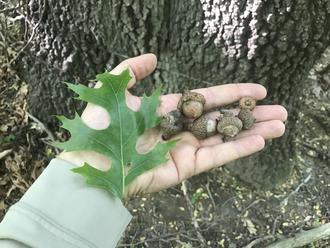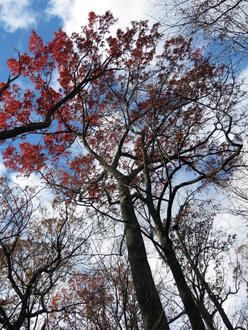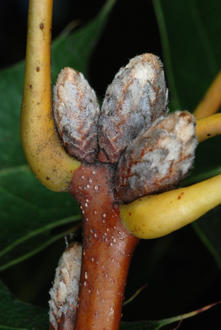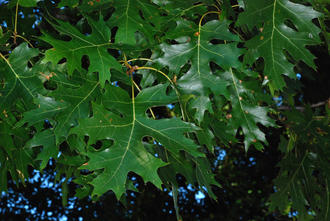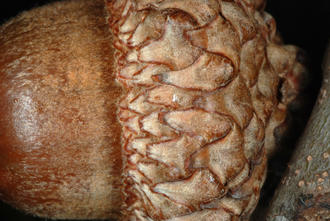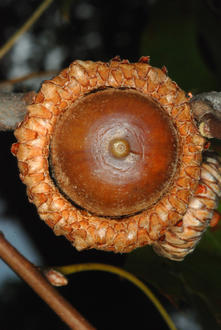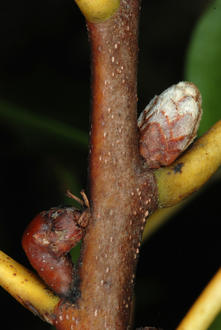Scarlet Oak (Quercus coccinea Münchh.)
↑Summary
A large, fast-growing, short-lived red oak of dry upland sites, named for the dark red color of its fall foliage.
↑Similar Plants
↑Habitat
Most commonly found on ridges and upper slopes in mountains and hilly terrain. Reaches to 5,000 feet in elevation in the southern Appalachians, but most common below 3,000 feet. Occasionally found in valleys or bottomlands, where it is limited to coarser, drought-prone soils.
Found in a range of soil types, but most common in sandy or gravely soil, in mesic to dry conditions. Prefers acidic soil that is low in clay particles, calcium, and magnesium. Requires good drainage.
Mostly limited to early-successional stages of forests, including forests that experience regular disturbance from fire, drought, or disease. Can form a climax community in the absence of disturbance on very dry sites, such as on upland sites in pine barrens. This species is less shade-tolerant than white, black, and chestnut oaks, and tends to occupy earlier successional stages in forests, being replaced by these species on sites able to support them. It is more drought-tolerant than white oak.
Tends to occur on sites that experience infrequent, but severe fires, as it is well-adapted to colonize burned sites, but not as well-adapted as other oaks to survive fire and does not survive long enough to produce seed on sites that burn frequently.
↑Life Cycle
Acorns germinate underground, and do best in areas with a thin covering of moss and lichen or thin leaf litter (<1in.) It is not clear whether seedling growth is inhibited by litter, or whether litter tends to be deeper in areas where seedling growth is inhibited by light competition from trees and shrubs.
Seedlings establish best under an open forest canopy, under higher-light conditions than preferred by white or chestnut oak. Due to large energy reserves in the acorn, seedlings are not particularly demanding about site characteristics during their first year, but they often die after about a year in low-light conditions. Due to its poor survival in low lighting, this species is less likely than other oaks to form long-term seedling banks on shady sites. However, on sufficiently bright sites, seedlings will resprout vigorously if top-killed, and can survive in this way for many years, with more vigorous growth in each successive year.
Growth is rapid for the first 5 years, among the fastest of any oaks in its range. Growth slows around 20 years of age, which is about when seed production starts. Seed production peaks around 50 years of age, and is irregular, with good crops occurring every 3 to 5 years on average. Growth each year is concentrated in three flushes, with the first and second flush showing extensive stem growth. The third flush usually has minimal growth, probably reflecting this species' dry habitat.
Saplings less than 4 inches in diameter reliably resprout if top-killed, but rate of resprout quickly declines past this point. Resprouting plants initially show many stems, which usually eventually self-prune to a single stem within several decades.
This species is short-lived for an oak, with a typical lifespan of about 80 years.
↑Faunal Associations
The acorns are an important food source to animals, including mammals such as squirrels, chipmunks, mice, and white-tailed deer, and larger birds such as wild turkeys, blue jays, and woodpeckers. The smaller size of the acorns than some oaks makes this species relatively more important to slightly smaller animals.
Deer occasionally browse young foliage, but usually only eat it during the brief period when it is soft, or if other food is not available.
The canopy and cavities in mature trees are both important as nesting sites for birds.
Scarlet oak supports numerous insects, mostly insects that feed on oaks in general. Scarlet oak tends to retain larger dead branches and tends to rot easily, which, combined with its rapid growth, can make it an excellent source of nesting cavities, as well as food for insects.
↑Uses
Widely planted as a landscaping plant and large shade tree, where it is prized for its bold fall color. Slightly less commonly planted than northern red oak (Quercus rubra) and pin oak (Quercus palustris).
The wood is usually lumped together with other red oaks, and like them it is valued for being both workable and strong, but is not particularly durable due to being prone to rot. It is used primarily for cabinetry and furniture, also in interior trim, flooring, and veneer. Although this species is common and its rapid growth makes it attractive, its use in sustainable forestry can be tricky because of the tendency for other more shade-tolerant trees to seed in under it, and then replace it following harvest.
↑Related Plants
Numerous other oaks of the red oak group (Lobatae) are found in this species' range. The most closely related is jack oak (Quercus ellipsoidalis), which only overlaps in a small east-west zone of the Great Lakes region. After this species, the next closest relative is thought to be black oak (Quercus velutina), followed by a grouping that includes the four species Shumard's oak (Quercus shumardii), mapleleaf oak (Quercus acerifolia), texas red oak (Quercus buckleyi), and northern red oak (Quercus rubra). Of these, only Shumard's and northern red oak overlap in range.
Scarlet oak is able to hybridize with even more distantly-related species of the red oak group; hybrids have been reported with bear oak (Quercus ilicifolia) and pin oak (Quercus palustris).
↑Links & External Resources
• Scarlet Oak | The Wood Database (About This Site)
• Scarlet Oak | Fire Effects Information System (FEIS) (About This Site)
• Quercus coccinea (Scarlet Oak) | USDA PLANTS Database (About This Site)
• Quercus coccinea | Go Botany (About This Site)
• Scarlet Oak | iNaturalist (About This Site)
• Quercus coccinea (Scarlet Oak) | Missouri Botanical Garden Plant Finder (About This Site)
• Scarlet Oak | Virginia Tech Dendrology Factsheets (About This Site)
• Scarlet Oak | Silvics of North America (About This Site)
• Quercus coccinea | Biota of North America Project (BONAP) (About This Site)
• Quercus coccinea | NatureServe Explorer (About This Site)
• Quercus coccinea | Flora of North America (About This Site)
• Scarlet Oak | Maryland Biodiversity Project (About This Site)
• Quercus coccinea Muenchhausen (Scarlet Oak) | Digital Atlas of the Virginia Flora (About This Site)



